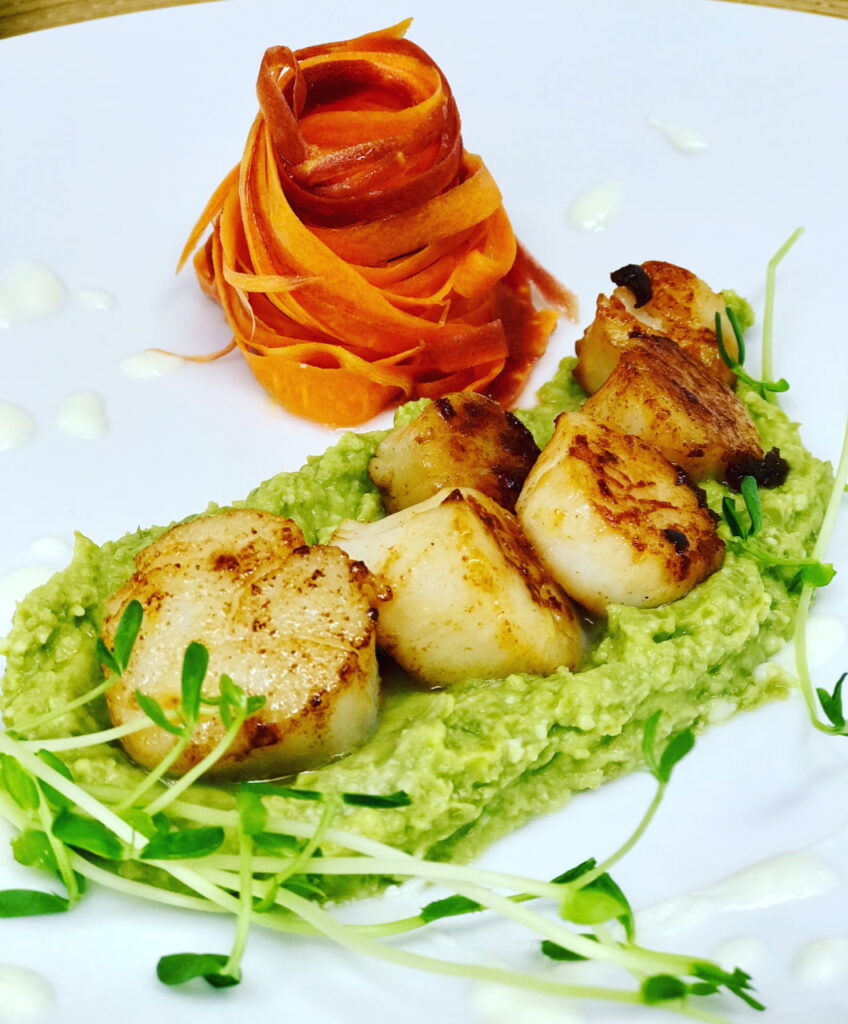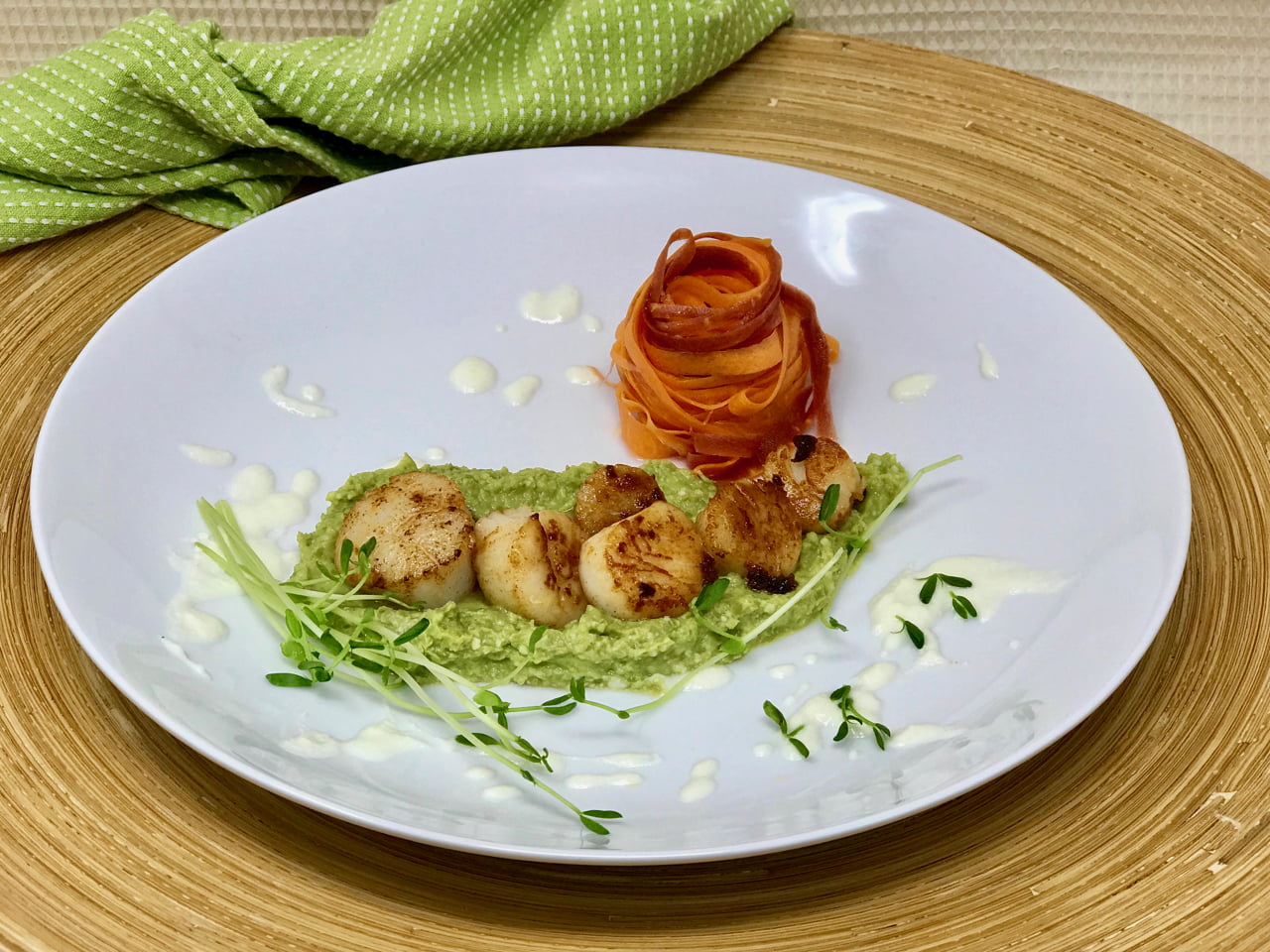Seared Scallops Over Pea Pesto, with garden fresh peas, perfectly seared scallops, dotted with a rich beurre blanc to kick off my Spring and Summertime dishes!
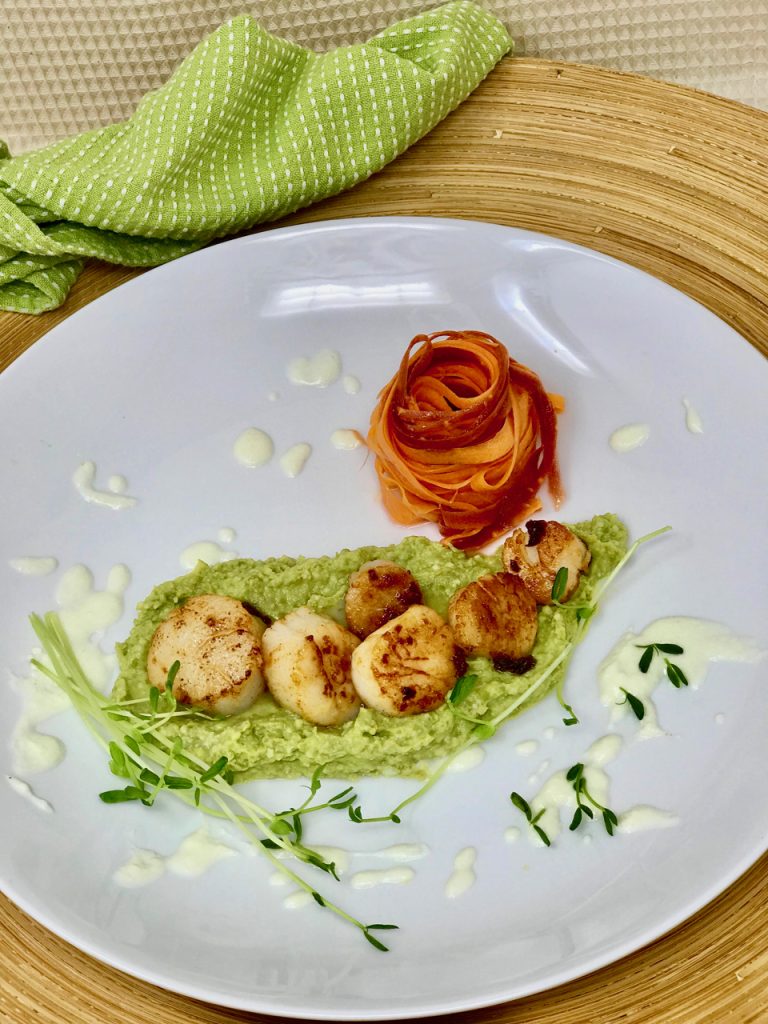
What Is Pea Pesto?
The real question; what isn’t pesto!
Originating in Italy, pesto is basically a paste, used to flavor a variety of foods. The word pesto itself, simply means ‘pounded’.
In ancient times, it would have been pounded with a mortar and pestle, kind of like a rock pressing against another rock!
Softened blanched garden peas are pounded (pureed), into a paste, with fresh herbs, garlic and olive oil.
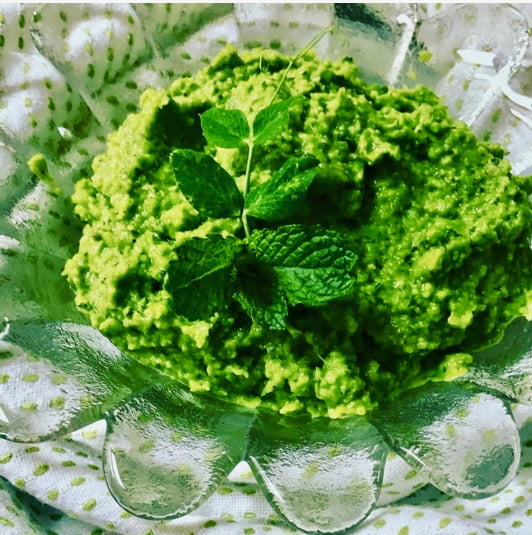
Homegrown Peas
Growing peas, not unlike so many other homegrown ingredients we cook with, is relatively easy to do, just need a little space or a few deep pots.
Of course there are several types of peas we can grow but for much of my cooking, I plant English peas, also known as garden peas.
Harvesting peas from the pods when they are plump and full happens rather quickly once delicate flowers form on the plants, that turn into peas.
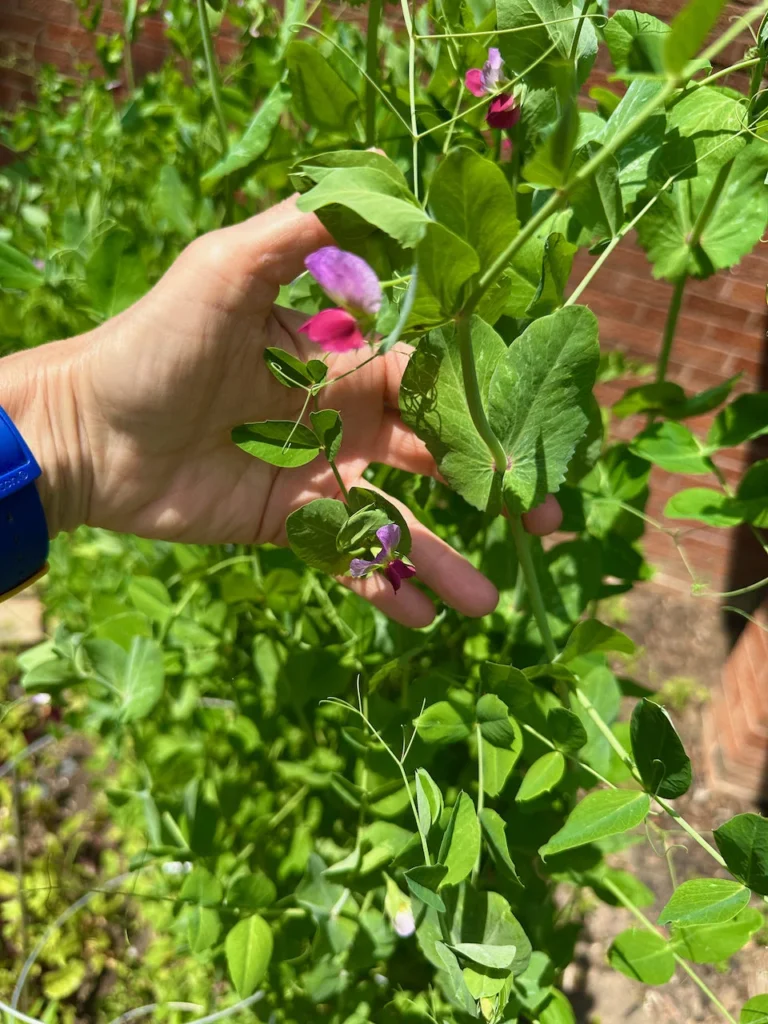
Easy To Plant Garden Peas
Once the doldrums of winter begin to subside, I plant peas outside from seeds in a spot that gets morning sun.
As soon as I see leaves sprout from the ground, I place cages (like tomato cages), over small clusters of the sprouts.
By June, they are beautifully grown, hanging in clusters and just waiting to be picked.
Once shelled I have lots of peas to use right away or tuck plenty in my freezer for later in the year, with their fresh garden flavor.
Garden Fresh Pea Pesto
While I have created so many dishes from these fresh green peas, I first start with a huge batch of Garden Fresh Pea Pesto.
Once the pesto is made, other recipes and dishes just seem to magically emerge:
- Shrimp and Pea Pesto in Wonton Cups – shaped in muffin tins and filled with spicy pea pesto and topped with sauteed shrimp.
- Pea Pesto Crostini – An Easy Pea Pesto Crostini made with homegrown or market herbs and peas make for the perfect spread over rustic bread for summertime meals.
Professional Chef Tips On Scallops
When you have a son who is a professional chef, mama asks lots of questions, and often places an order for the best quality products!
The most important tips on cooking scallops?
- Remove the tiny piece that appears to blend in with the scallop called the abductor muscle, it is tough when cooked.
- Dry the scallops as best you can before cooking them.
- Place the scallops in a really hot pan with a bit of oil and butter.
- Cook quickly, about 2 minutes, on each side and not much more.
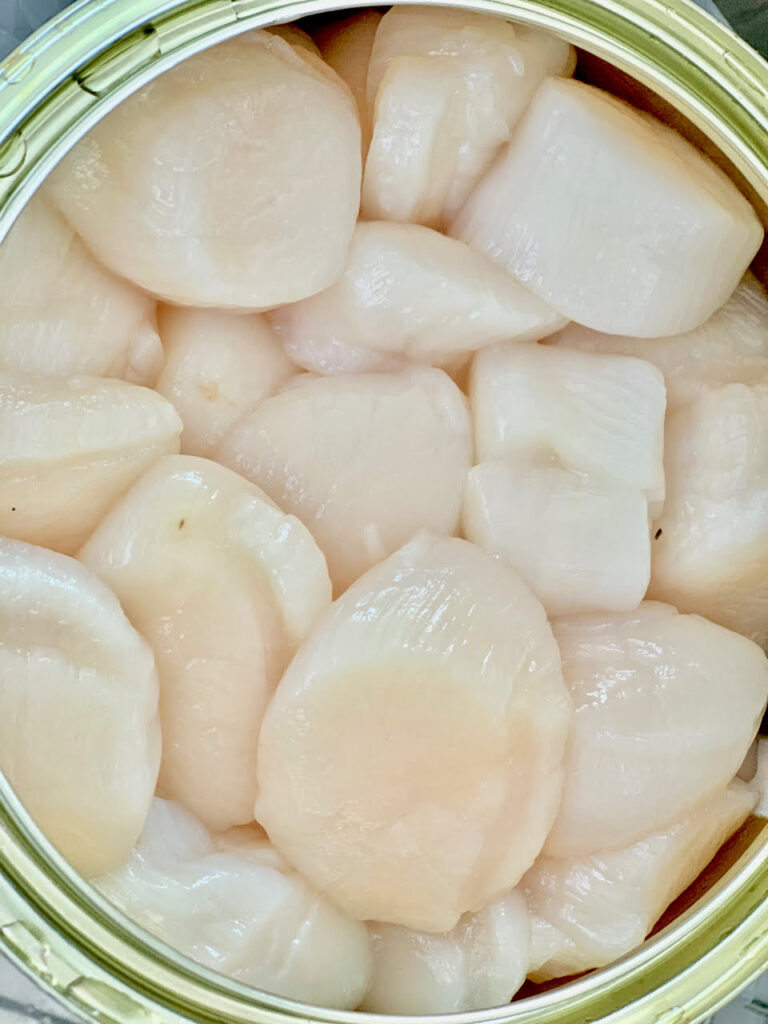
Living With A Professional Chef In The Family
It’s funny how we learned so much about who our adult children by watching them closely as they develop when kids.
My son started cooking at age eleven with either me or his grandma, of which she said, “That one, is going to be your chef.” He is, and I learn so much from him.
My most memorable meal, one in which I was asked to execute on a television series I am featured in, is the birthday meal my son often prepares for me!
Home Cooked Seared Scallops Are The Best!
I do not enjoy going to a restaurant for special occasion meals, simply because I have been spoiled with the best home cooked foods nearly all my life.
And so, when I want to impress guests in my home with a lovely evening meal, it is often seared scallops over pea pesto.
Scallops cook quickly, which allows time with guests rather than away from them in the kitchen, and the pea pesto is made in advance and quickly warmed before serving the scallops on top.
The best pea pesto starts in my garden, all the way back in early spring, with seeds and dirt!
How To Make Seared Scallops Over Pea Pesto With Beurre Blanc
There are three components to this decadent, flavorful, restaurant quality dish that you can make at home. They are each easy, so don’t be shy!
- Pea Pesto – blanched peas pureed with a hint of chili and fresh mint.
- Beurre Blanc – a rich sauce of white wine, cream and shallots.
- Seared Scallops – lightly dusted with smoked paprika and sautéed in butter.
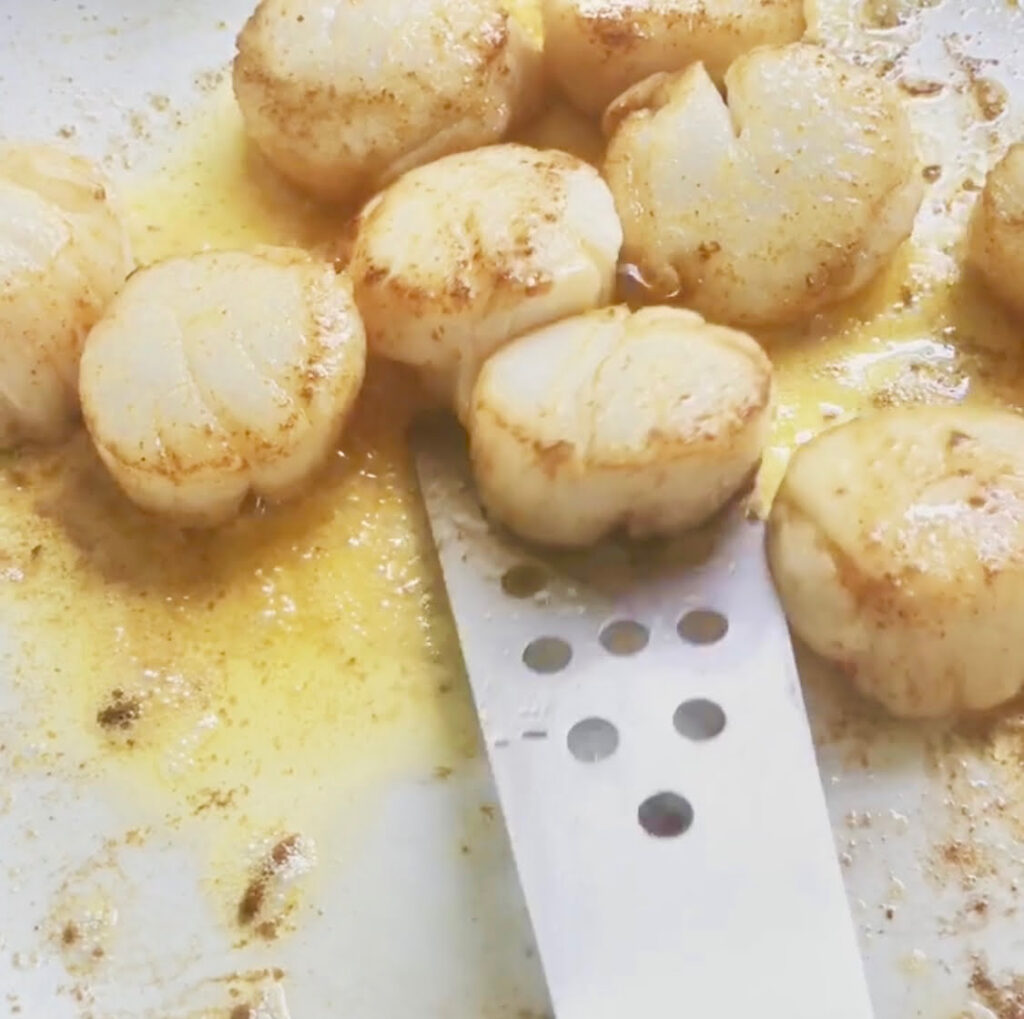
Ingredients Needed
- Peas, fresh garden peas when possible, or store bought English peas.
- Fresh mint is usually available year round, though it too grows easily in pots at home.
- Olive oil of good quality, not the olive oil that has very little color.
- Lemon juice, freshly squeezed.
- Salt brings out the natural sweetness of fresh peas.
- White pepper for its earthier flavor than black pepper.
- Garlic offers a bit of heat if raw or a nuttier flavor if roasted before adding to the pesto.
- Chili pepper if you prefer more heat than the earthy sweetness of the peas without the heat.
- Butter, unsalted.
- Shallots, instead of onions for a more delicate onion flavor.
- Dry white wine along with a bit of white balsamic vinegar for both their acidity and sweetness.
- Heavy cream adds the creaminess to the pea pesto.
- Scallops, with their muscle removed and scallops well dried.
- Paprika is optional.
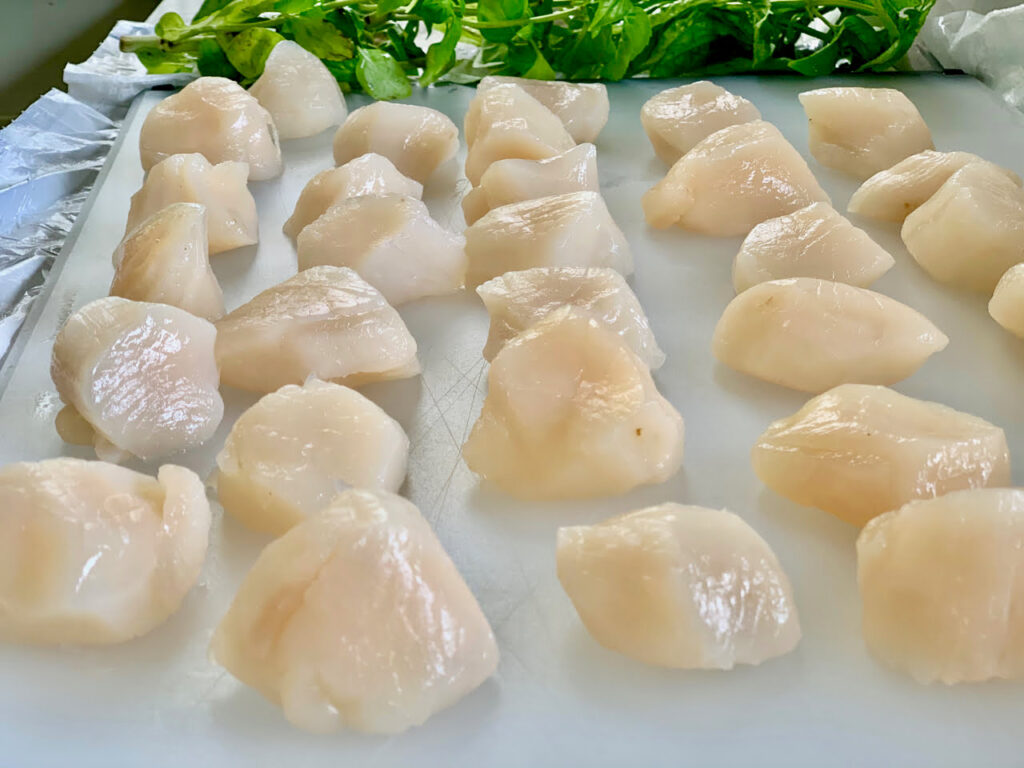
Equipment Needed
- Sauce pans, a heavy cast iron works great for the seared scallops while a stainless is just fine for making the beurre blanc sauce.
- Blender or Food Processor to puree the pesto.
- Measuring cup and measuring spoons
- Small Stainless bowls for the various components to this dish.
- A few utensils such as a wooden spoon, a slotted spoon, a wire whisk and a spatula.
- Stovetop or burner
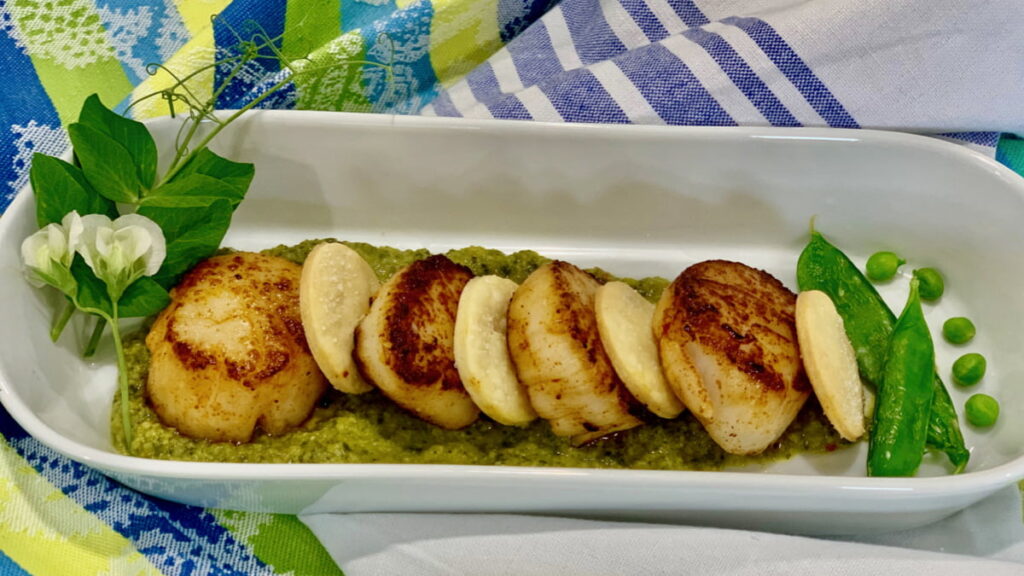
Seared Scallops Over Pea Pesto
Equipment
- Saute pan
- Food processor or blender
Ingredients
- Spicy Pea Pesto
- 2 cups Blanched peas
- 1/4 cup Fresh mint
- 1 tbsp Olive oil
- 2 tbsp Lemon juice
- 1 tsp Salt
- 2 Garlic cloves
- 1/2 tsp Chipotle or chili pepper
- Beurre Blanc
- 8 tbsp Butter
- 2 tbsp Shallots finely chopped
- 3 tbsp Dry white wine
- 2 tbsp White balsamic vinegar
- 1/2 cup Heavy cream
- Salt and White pepper to taste
- Seared Scallops
- 16 Large scallops 4 per plate
- 1/2 tsp Paprika
- 2 tbsp Butter
- Salt – to taste
Instructions
- Pesto – Place the blanched peas with the other pesto ingredients into a blender or food processor. Whirl until pureed. Set aside in a small metal bowl, sitting on top of a small pot of simmering water. (double boiler style). This will keep the pesto warm without continuing to cook the peas, therefore removing their vibrant color.
- Beurre Blanc – Place 1 tablespoon of butter in a medium hot pan and sauté the shallots. When they begin to change color, add the vinegar and wine and simmer until reduced by half.
- Add the cream, salt and pepper and boil for 1 minute. Reduce the heat and whisk in the remaining butter, one tablespoon at a time, whisking all the while until the sauce begins to thicken. Remove from the burner with a lid on to keep it warm.
- Scallops – Pat the scallops dry and set out on a plate. Lightly sprinkle salt and paprika on both sides of the scallops.
- Heat the butter in a non-stick pan. As soon as the butter begins to turn a golden color, place the scallops in the pan. Cook 2 – 3 minutes on one side until a nice sear appears, turn them over and cook another 2-minutes and remove.
- Plating – Place a healthy schemer of warm pea pesto on the plate. Place seared scallops on top of the pesto. Drizzle the beurre blanc across the scallops and serve with a garnish of micro greens or peas tendrils!
Video
Notes
- Another element or garnish, which I have used here, is long shaves of carrot, quickly tossed in a hot pan with butter, twirled (pasta style), and placed on the plate.
